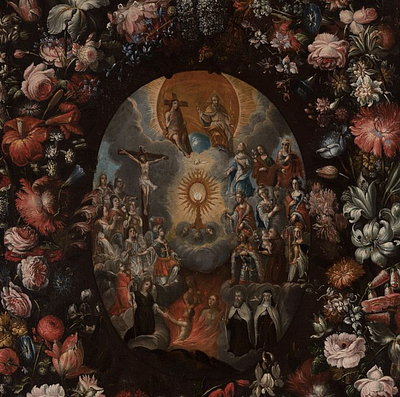Attributed to FRANCISCO HERRERA "El mozo" (Seville, 1627- Madrid, 1685). "The birth of the Virgin. Presents faults in the frame, and period frame.
Lot 71
About Seller
Setdart Auction House
Carrer Aragó 346
Barcelona
Spain
Setdart Subastas was born in 2004 and is currently the first online art auction in Spain with solidity, prestige and reliability guaranteed by our more than 60,000 users. Setdart has a young, dynamic and enterprising team ready to successfully manage the purchase and sale of art works through custom...Read more
Estimate:
EUR€8,000 - EUR€10,000
$8,333.33 - $10,416.67
Absentee vs Live bid
Two ways to bid:
- Leave a max absentee bid and the platform will bid on your behalf up to your maximum bid during the live auction.
- Bid live during the auction and your bids will be submitted real-time to the auctioneer.
Bid Increments
| Price | Bid Increment |
|---|---|
| EUR€0 | EUR€10 |
| EUR€200 | EUR€25 |
| EUR€500 | EUR€50 |
| EUR€1,000 | EUR€100 |
| EUR€3,000 | EUR€200 |
| EUR€5,000 | EUR€500 |
| EUR€10,000 | EUR€1,000 |
| EUR€20,000 | EUR€2,000 |
| EUR€50,000 | EUR€5,000 |
About Auction
By Setdart Auction House
Jul 14, 2021
Set Reminder
2021-07-14 06:30:00
2021-07-14 06:30:00
America/New_York
Bidsquare
Bidsquare : OLD MASTERS
https://www.bidsquare.com/auctions/setdart-auction-house/old-masters-7202
Setdart Auction House sofia@setdart.com
Setdart Auction House sofia@setdart.com
- Lot Description
Attributed to FRANCISCO HERRERA "El mozo" (Seville, 1627- Madrid, 1685). "The birth of the Virgin. Presents faults in the frame, and period frame. Measures: 57 x 43 cm; 79 x 64 x 7 cm (frame). Under a break of glory starring the figure of God holding the city and pointing to the figure of the Immaculate Conception, a scene of earthly character develops. It shows a woman lying on a luxurious bed, holding a baby in her arms. Next to the bed an adult man, elegantly dressed, approaches the bed with a magnanimous gesture. The figures can be identified with St. Joachim, the Virgin and Mary. The theme of the Nativity of Mary was frequently represented in art, as part of the cycles of the Life of the Virgin. These depictions, both medieval and later, are often valuable documents that provide information about the domestic interiors and customs of their time. The cycle of the Life of the Virgin spread during the Middle Ages, basing its iconography on the Gospels and, above all, on the apocrypha collected in the "Golden Legend" of Santiago de la Voragine. Anne and Joachim, Mary's parents, had been married for many years without conceiving children. In order for her conception to be immaculate, that is, without the lust of original sin, it took place when the spouses embraced at the Golden Gate of Jerusalem. According to the text, this is how St. Anne became pregnant and, nine months later, gave birth to the Virgin Mary. The birth of Mary is traditionally depicted as we see it here, as a genre scene set in an interior of the period. In the absence of details concerning the Virgin Birth in the Bible, art has turned to the Apocryphal Gospels for inspiration. The Protoevangelium of James provides the names of her parents (Joachim and Anne), and tells that she, barren, withdrew to fast in the desert for 40 days, and an angel appears to her, who then communicates the news to her husband. Similar stories are found in other texts: the Gospel of the Nativity of Mary, the Armenian Gospel of the Infancy, etc. Due to its aesthetics, the work is related to the artistic production of Francisco Herrea, "El mozo" (Seville, 1627- Madrid, 1685), son of Francisco Herrera el viejo, "El mozo", began his artistic training under the guidance of his father, although he finally continued his studies in Rome. At first he dedicated himself to architecture, although he soon began to work with the fresco technique. In 1656 he returned to Seville, and four years later, in 1660, together with other painters such as Murillo, Valdes Leál and Camprobín, he founded the drawing academy of Seville, of which he was the deputy director. A year later he moved to Madrid where he worked on the Frescoes of San Felipe el Real. It was in this project, with which he caught the attention of Philip IV, who hired him to paint the dome of the chapel of Our Lady of Atocha and also appointed him court painter and superintendent of the royal buildings. Later, with the appointment of Charles II, he continued to form part of the court, and was appointed master of the royal works. His work is characterized by specialization in the still life genre, although he was also an appreciated portraitist, without reaching the success of his father. However, due to his dynamic and colorful works, where a light and versatile brush movement stands out, he became a master of the Baroque, fundamental in the development of Madrid painting in the last third of the 17th century.
- Shipping Info
-
In-house shipping available. Please inquire at admin@setdart.com.
-
- Buyer's Premium



 EUR
EUR CAD
CAD AUD
AUD GBP
GBP MXN
MXN HKD
HKD CNY
CNY MYR
MYR SEK
SEK SGD
SGD CHF
CHF THB
THB



















